44 African Grey Parrot Facts (Complete Guide) Talkative Congo Grey Parrot
African grey parrots are famous for their intelligence and vocabulary. In this post, you’ll learn 44 African grey parrot facts, including differences between Timneh and Congo greys, ranges, diet, speaking ability, lifespan, appearance, and more. Plus lots of photos, videos, and resources.
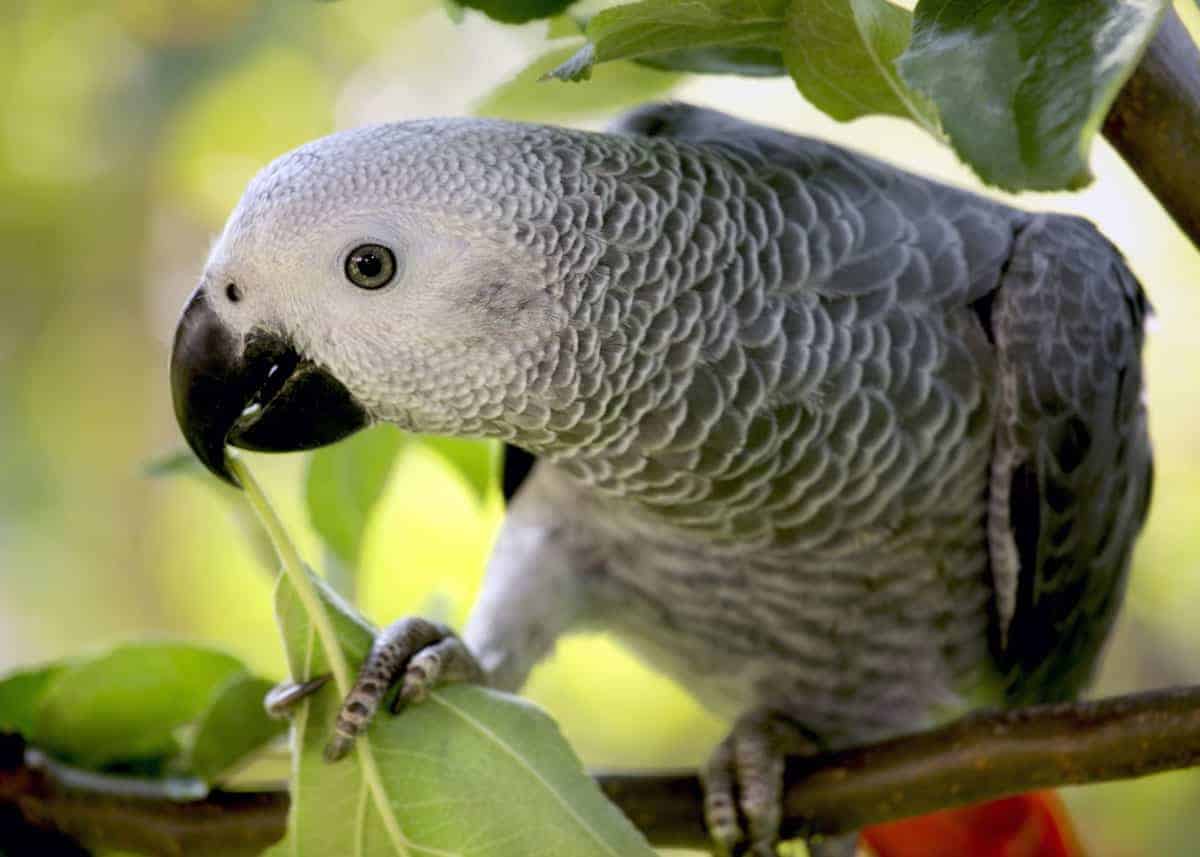
Guide to the African Grey Parrot
Polly wants a cracker? African grey parrots are some of the most intelligent animals in the world.
Not only can they mimic human speech, but they can also learn to answer questions, express affection, and use things like deductive reasoning. Some studies say that their intelligence is equivalent to a kindergartner!
Are you ready to learn even more African grey parrot facts? Let’s get started.
African Grey Parrot Overview
- Latin name: Psittacus erithacus
- Range: Equatorial Africa (Ghana, Gabon, Kenya, Uganda, Angola, Cameroon, Congo and the Ivory Coast)
- Population Status: Endangered
- Size: 12 – 16 inches (height), 0.8 – 1.4 pounds (weight)
- Wingspan: 18 – 20 inches
- Diet: Fruits, nuts, seeds, flowers, small insects
- Physical features: Grey body with yellow eyes and red tail
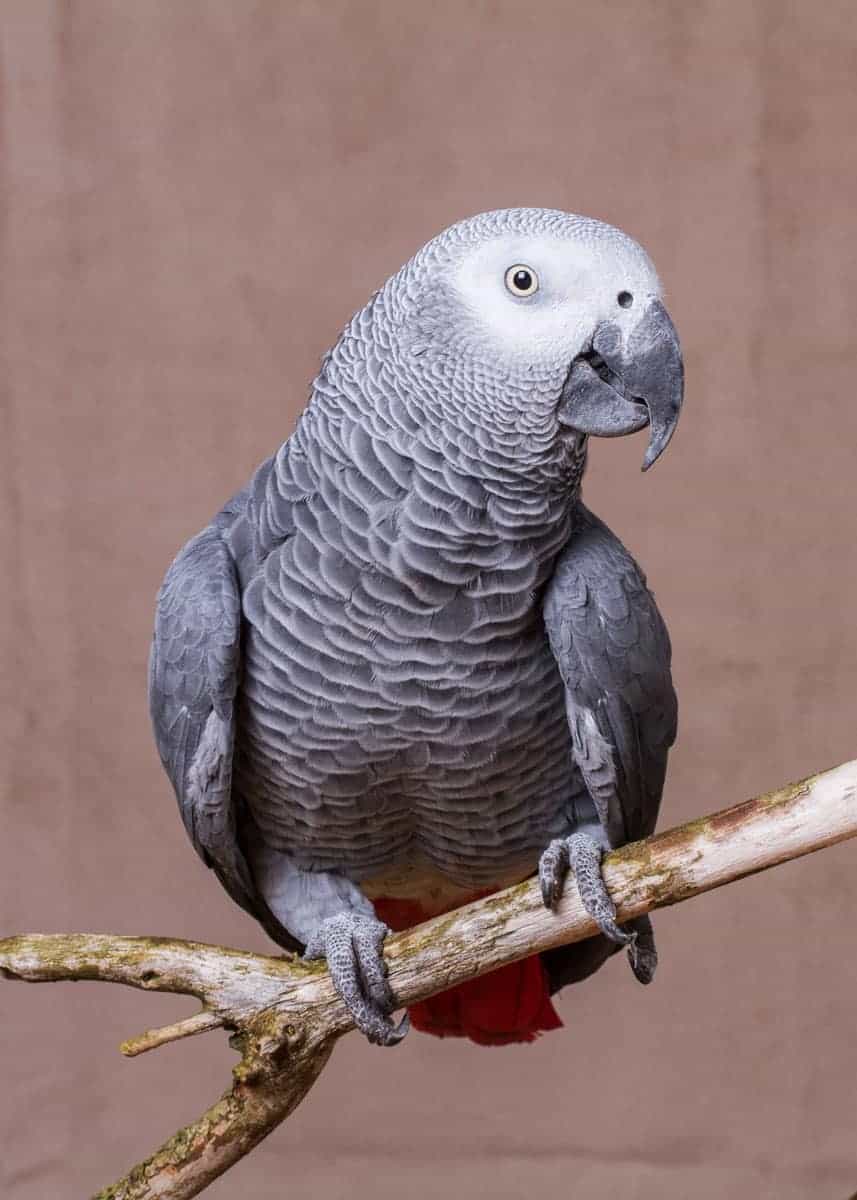
Learn more about the Birds of Uganda
44 African Grey Parrot Facts
1. Where does the African grey parrot live?
The African grey parrot is found in equatorial Africa, meaning that it’s native to the African countries that are found near the equator.
These countries include Ghana, Gabon, Kenya, Uganda, Angola, Cameroon, Congo and the Ivory Coast.
2. What other names does the African grey parrot have?
It’s sometimes called a plain “grey parrot,” but since this term can also be applied to Timneh grey parrots, it’s good to clarify which breed you’re talking about.
The African grey parrot is also known as the Congo grey parrot.
On a side note, the Timneh parrot is now classified as a distinct species. It is also known as the Timneh grey parrot or Timneh African grey parrot. It is sometimes referred to by the acronym TAG.
3. What are the types of African grey parrots?
There are two types of grey parrots found in Africa:
- African grey parrot (Psittacus erithacus)
- Timneh grey parrot (Psittacus timneh)
They’re often confused with each other. They were classified as a single species until ornithologists separated them in 2012!
They have a lot of similarities in diet, region, appearance, and reproductive habits, so it’s easy to understand why birdwatchers see double.
4. Differences between Timneh and Congo grey parrots
They might seem identical from a distance, but when you pull out your binoculars and take a closer look, you’ll notice some key differences between African grey (Congo grey) parrots and Timneh grey parrots:
- The African grey parrot has a vivid red tail, while the Timneh gray parrot has a darker, more maroon tail.
- The African grey parrot is slightly larger. It clocks in at 12 – 16 inches and 0.8 – 1.4 pounds, while the Timneh grey parrot maxes out at 11 – 13 inches and 0.6 – 0.8 pounds.
- The African grey parrot is native to central Africa (Ghana, Kenya, Uganda, Congo), while the Timneh grey parrot is native to western Africa (Guinea, Mali, Sierra Lorne).
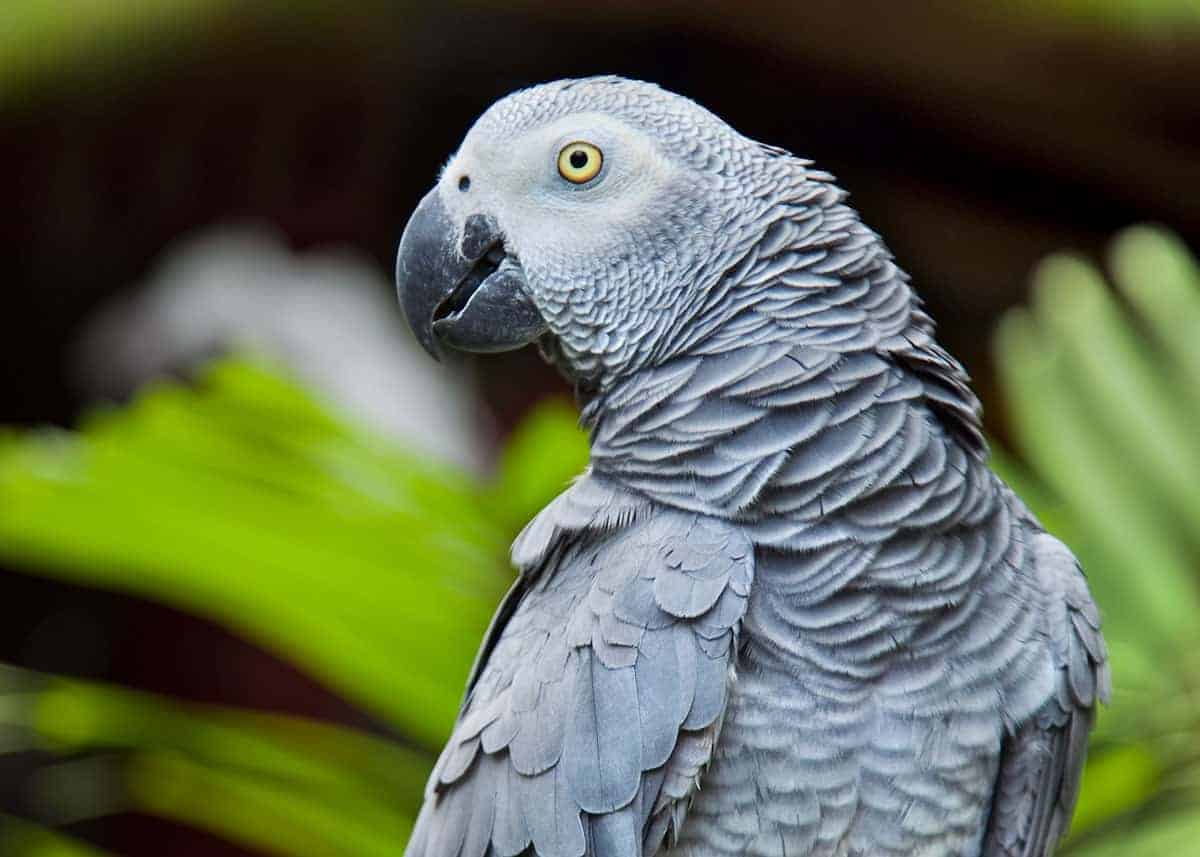
5. How smart is an African grey parrot?
It’s said that they have the cognitive abilities of a 3 to 6-year-old human! One of the most remarkable things about African grey parrots is their intelligence.
There’s a list of impressive things that African grey parrots can do. Their skills include:
- mimic human speech
- identify shapes and colors
- learn number sequences
- ask unprompted questions
- hold entire conversations with their owners
They’re even capable of things like deductive logic and probabilistic reasoning. They rank up there with dolphins and gorillas in terms of brainpower.
Long story short, these are whip-smart birds!
6. Can African grey parrots talk?
Yes. African grey parrots can both talk and sing.
They can be taught specific words and phrases for training purposes, or they can pick up sounds from their environment over time.
It’s quite common for African grey parrots to surprise their owners with jingles that they overheard on TV.
7. Can African grey parrots understand what they say?
Some people will argue that parrots can only echo human sounds without realizing what they mean, but these people don’t know parrots. This is especially true of the hyper-intelligent African grey parrot.
All of the evidence suggests that they can learn, retain, analyze and share information when it’s relevant to them.
Here are some examples:
- Talked his way home: In Japan, a lost African grey parrot started repeating his owner’s name and address when he was scooped up and taken to a veterinary clinic. He knew that he was lost, and he knew what he needed to say to get back home.
- Understand words and sounds: In Vienna, African grey parrots were able to determine which containers held food even though they were given nothing but auditory clues. They were able to process words and sounds and comprehend what they meant.
- Asks clarifying questions: A famous African grey parrot named Alex was said to know more than 100 words. He could identify numbers, shapes, colors, and objects, and he would ask questions if he didn’t understand a task. According to the New York Times, he could also make demands like “wanna go back” if he was carried somewhere that he didn’t like. Alex even has his own book.
All of these things suggest that African grey parrots understand the purpose of communication.
They might not be able to hold an intellectual debate, but they’re thinking and expressing themselves in ways that other animals simply can’t. Imagine if your dog looked back at you one day and asked, “But why should I fetch?”
8. What is the habitat of the African grey parrot?
African grey parrots like thick, dense forests, but they’ve also been spotted at forest edges and clearings.
They usually stick to low canopies; the highest elevation that they’ve ever been recorded is 2,200 feet. They seem to have a preference for water. They often roost in trees that are over rivers and lakes.
9. Where do African grey parrots nest?
When it’s time to nest, African grey parrots move into tree holes. The cover can help to protect their eggs from predators.
They usually hop into unoccupied tree holes, but they’ve been known to steal the nests of woodpeckers and other small birds.
10. Can African grey parrots fly?
Yes, African grey parrots are capable flyers, but they don’t always do it as much as other birds.
For example, they use their beaks and claws to move around tree canopies rather than flying from branch to branch.
11. Why is the African gray parrot considered an “Old World” parrot?
If you’re new to ornithology, you might wonder why some species are considered “Old World” parrots while others are called “New World” parrots.
While they have some similarities, there are also key differences between the two:
- Old World parrots come from Africa and Asia, and New World parrots come from the Americas.
- Old World parrots know how to survive in hot, dry climates (Africa). New World parrots thrive in wet, humid rainforests (the Amazon).
- Old World parrots create more bird dust than New World parrots, which might be because their species have adapted to different habitats. They’re also more susceptible to deadly avian illnesses like proventricular dilatation disease (PDD).
12. What does the African grey parrot look like?
Though the African grey parrot might look like a monochrome bird, there are more shades and subtleties to its plumage than you might think!
For example, it isn’t a solid grey. Its head and wing feathers are a darker grey, while its undercoat feathers are a lighter, more silver grey. The head feathers are also streaked and tinged with white.
There are a few other splashes of color as well. The African grey parrot has yellow eyes and a black beak. Its tail feathers are a vibrant red. Mutations can occasionally turn the parrots red, blue, brown, or albino.
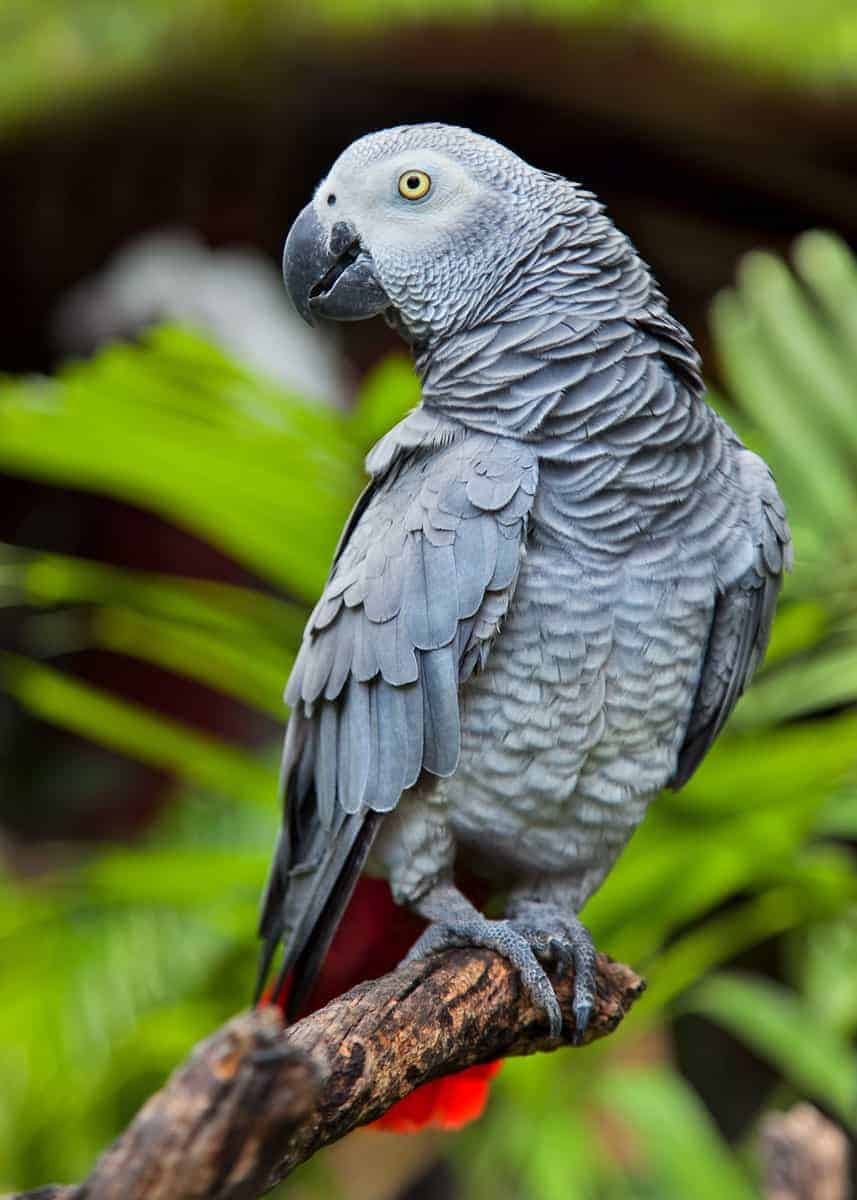
13. How tall is an African grey parrot?
African grey parrots are usually about a foot tall. They measure 12 – 16 inches, with their average height being 13 inches.
14. How much does an African grey parrot weigh?
African grey parrots can range from 0.8 – 1.4 pounds, but their average weight is a little under a single pound.
15. What is the African grey parrot’s wingspan?
African grey parrots can spread their wings about 18 – 20 inches depending on their unique height and weight.
16. Are African grey parrots friendly or aggressive?
Generally, African grey parrots are very friendly. In the wild, they are gentle with each other. And as pets, they are generally friendly with their owners.
African grey parrots are highly social birds that can live in flocks of 50 or more. They have big, multi-generational broods where the young and old mingle freely. Socialization and vocalization is a big part of their everyday life. They even coordinate hunting parties when it’s time to eat!
Things can be a bit different in captivity. Since space is limited, African grey parrots can get territorial. They might not like being housed with other birds, or they might become overly defensive of “their” toys and snacks. They’re also intelligent creatures that require a lot of attention and stimulation, and if they don’t get it, they can cop an attitude with their owners. A very bored or frustrated bird might even lash out at you.
That said, you have nothing to fear from a happy, healthy African grey parrot. They’re like any creature: They might cause problems when treated badly, but if you’re raising them right, they can make wonderful companions.
17. How long do African grey parrots live?
The lifespan of an African grey parrot is around 40 – 60 years in captivity.
This number drops dramatically in the wild; they only live around 20 – 25 years in their natural habitats.
18. Why is the African grey parrot considered a “true” parrot?
“True parrot” is a name given to a specific family of parrots.
They have hooked beaks, blunt tongues, long claws, and a similar diet of fruits and seeds. True parrots include macaws, parakeets, caiques, and African grey parrots.
19. Is the African grey parrot always grey?
No. Despite the name, African grey parrots aren’t always monochrome.
There are albino birds that are white or blue-white, and mutations can occur in the wild that give African grey parrots a mottled appearance with several different shades of red, brown, white, and silver streaked throughout their bodies.
There are also breeders that have experimented with making African grey parrots redder. Some of them have been born with all-red or all-pink plumage instead of grey. These specimens are usually sold for crazy prices since they’re so rare!
20. What eats an African grey parrot? Predators and Threats
African grey parrots are vulnerable to larger, stronger birds like raptors and vultures.
Their eggs are also a favorite of monkeys. This is one of the reasons why mothers guard their nests so fiercely; they never know when they might be sharing a tree with a long-fingered predator.
Pythons also eat parrots and their eggs.
African grey parrots can also fall victim to land animals when they descend to the ground for hunting or foraging. They don’t have any specific enemies here, but they can be pounced on by all kinds of foxes, jackals, snakes, and cats.
The biggest threat to African grey parrots, however, isn’t something that flies in the sky or slithers on the ground. It’s human beings.
21. Is the African grey parrot endangered?
Yes.
The International Union for the Conservation of Nature (IUCN) has officially marked them as endangered. The Convention on International Trade in Endangered Species (CITES) has banned their international trade. Their population is on the decline in every African country that they inhabit.
Despite the efforts being made to protect them, however, African grey parrots are still in high demand. They’re bred by exotic breeders or caught in the wild to be sold or traded. One report suggests that 20% of the global African grey parrot population is lost to the bird market every year.
22. How many grey parrots are left in the world?
It’s hard to know how many African grey parrots are left. Some estimates say that there might be less than a million; others put the number at a few million.
We know that they’re dying off fast: In one of the most sobering statistics, Ghana has lost 99% of its African grey parrots since 1992.
23. What do African grey parrots eat?
African grey parrots are herbivores and occasionally omnivores. Their primary diet consists of fruits, nuts, seeds, and flowers, but they’ll also munch on snails and small insects when given the opportunity.
In captivity, they can survive on bird pellets, but their diet needs to be supplemented with fruits and veggies. They’ll eat apples, bananas, cucumbers, peas, potatoes, green beans and fresh kale.
Here’s a glimpse of one feeding in the wild.
24. How do African grey parrots hunt?
While most of their food is found through foraging rather than hunting, African grey parrots aren’t afraid to skewer a juicy bug when it stumbles across their path.
They don’t do their dining alone, however. African grey parrots are highly social animals that hunt in flocks, and they have an entire system for finding food in groups. They’ll start by gathering in a single tree with parrots crowded on every branch; then, when their numbers are sufficient, they’ll take turns descending to the ground and looking for sustenance.
The whole flock is never on the ground at the same time. Some are always on the lookout for predators, and even the hunters stay vigilant to danger. It’s very easy to scatter a group of African grey parrots since they’ll take off at the smallest sign of noise or movement.
25. What is the African grey parrot’s Latin name?
The scientific name of the African grey parrot is Psittacus erithacus. Here’s a breakdown of their entire lineage:
- Class: Aves (birds)
- Order: Psittaciformes (parrots)
- Family: Psittacidae (“true” parrots)
- Subfamily: Psittacinae (Old World parrots)
- Genus: Psittacus (African parrots)
- Species: Psittacus erithacus
26. Do African grey parrots mate for life?
It isn’t known whether African grey parrots mate for life, but they do form monogamous pairs that stick together for multiple mating seasons.
They’ll perform courtship rituals before accepting each other and laying eggs together, and both parents will feed, shelter, groom, guard, and socialize their babies. This is quite different from other bird species where the mom does everything and dad might not even stick around for the hatching.
With African grey parrots, parents are equal partners in mating and child-rearing.
27. At what age do African grey parrots lay eggs?
African grey parrots reach sexual maturity between 3 – 5 years. Males and females mature at the same rate.
28. How often do African grey parrots lay eggs?
African grey parrots lay eggs 1 – 2 times per year.
We don’t know much about their breeding season, but it seems to correspond to dry weather, so African grey parrots in different countries might lay eggs at different times.
29. How many eggs does the African grey parrot lay?
The eggs of an African grey parrot are white and tiny.
Mom usually lays 3 – 5 at a time, and the hatchlings will weigh just 0.42 – 0.49 ounces at birth. They’ll be red, bald, wrinkled, and hairless. They’ll develop a soft fuzzy layer of down before their first feathers start growing.
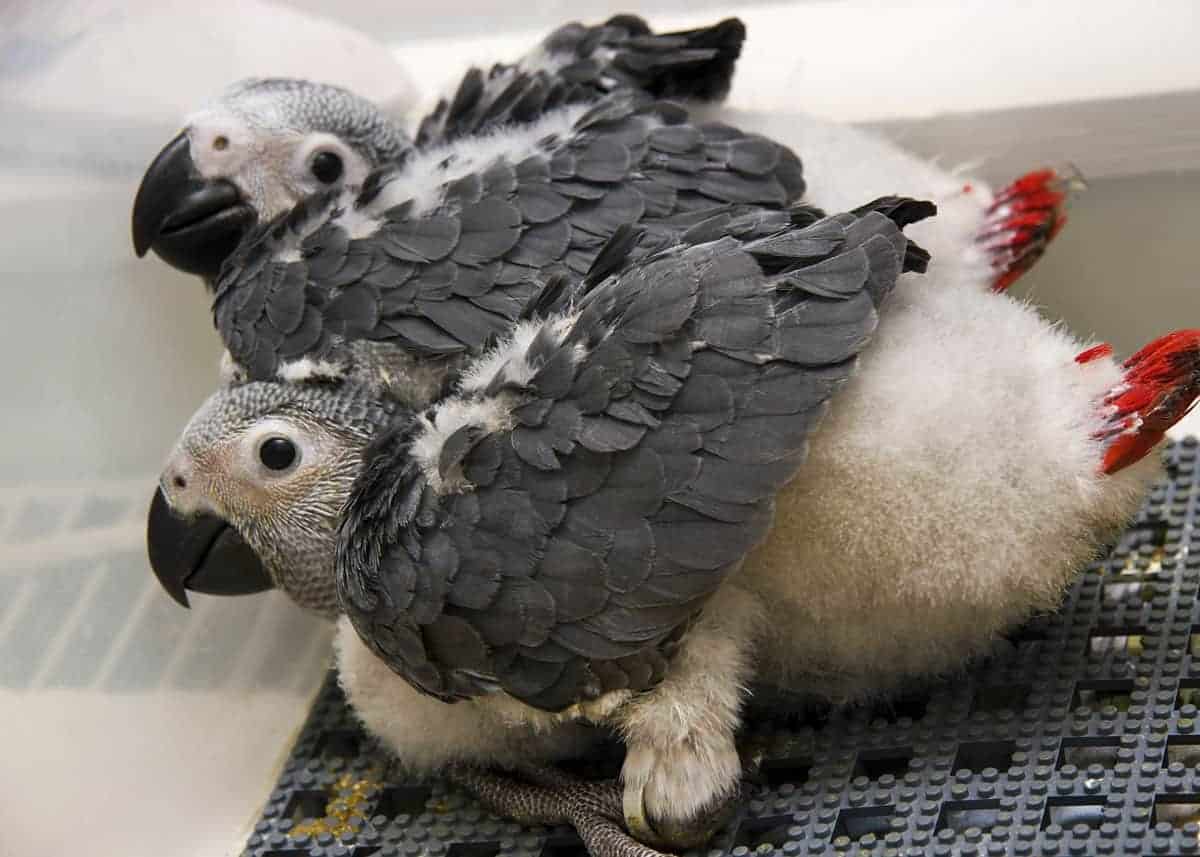
30. How do African grey parrots take care of their young?
It starts with incubating their eggs. It takes around 30 days for African grey parrots to hatch, and the female will hide in her tree hole and sit on them the entire time. She won’t move from her post; the male will do all the foraging, and he’ll come back to feed and guard her while she protects the all-important eggs.
Once the babies are born, mom and dad will be active parents together. Their main priority will be protecting the small, vulnerable hatchlings from predation, but they’ll also need to teach them how to eat, fly, forage and vocalize.
Young African grey parrots leave the nest around 12 weeks old, but they won’t go far.
They’ll stick with their parents for many months before they become fully independent. Everyone needs to learn the flock dynamics (including complex hunting formations) and the lessons take time.
31. What is the African grey parrots call?
In the wild, African grey parrots have a complex series of vocalizations. These include alarm calls, contact calls, distress calls, and hunting calls in addition to everyday chatting and preening when large flocks are together.
Research suggests that they have excellent hearing and can distinguish very minor note changes. They might even recognize the specific calls of their mates and children.
32. Are African grey parrots loud?
They definitely don’t belong in a library! African grey parrots are vocal birds that love to talk and sing.
While they aren’t automatically loud, they don’t have any sense of volume regulation, and they only stop chittering and chattering when they feel like it. As charming as they might be, you don’t want to bring home an African grey parrot if you value peace and quiet.
33. Do African grey parrots carry disease?
African grey parrots can come down with several worms, parasites, diseases, and infections. They can be surprisingly delicate birds. Most of these conditions are only dangerous to other members of the avian family, but one of them can be spread to humans: psittacosis.
Also known as “parrot fever,” psittacosis is characterized by rashes, headaches, high temperatures, joint pains, and nose bleeds. It’s often confused with typhoid fever or meningitis. Serious cases can require hospitalization.
To avoid getting psittacosis, make sure that you always wash your hands after playing with your parrot. Keep their cage clean, and use gloves when dealing with their droppings. Stay vigilant about their overall health. If you notice any suspicious symptoms in your parrot, don’t hesitate to contact your vet and get them checked out.
34. Do African grey parrots have any special significance in African culture?
African grey parrots are quite popular among the Yoruba people of Nigeria. During their annual Gelede festival, the grey face and blood-red tail feathers are painted on all kinds of costumes and masks.
African grey parrots are also linked with many spy and sentinel myths since they’re known for their vocalizations.
35. Where can I see the African grey parrot?
The African grey parrot can be found in a few zoos, including the Knoxville Zoo and the San Diego Zoo. It isn’t a common feature since it’s so rare and elusive in the wild. If you want to see an African grey parrot in the flesh, you might have to reach out to a breeder.
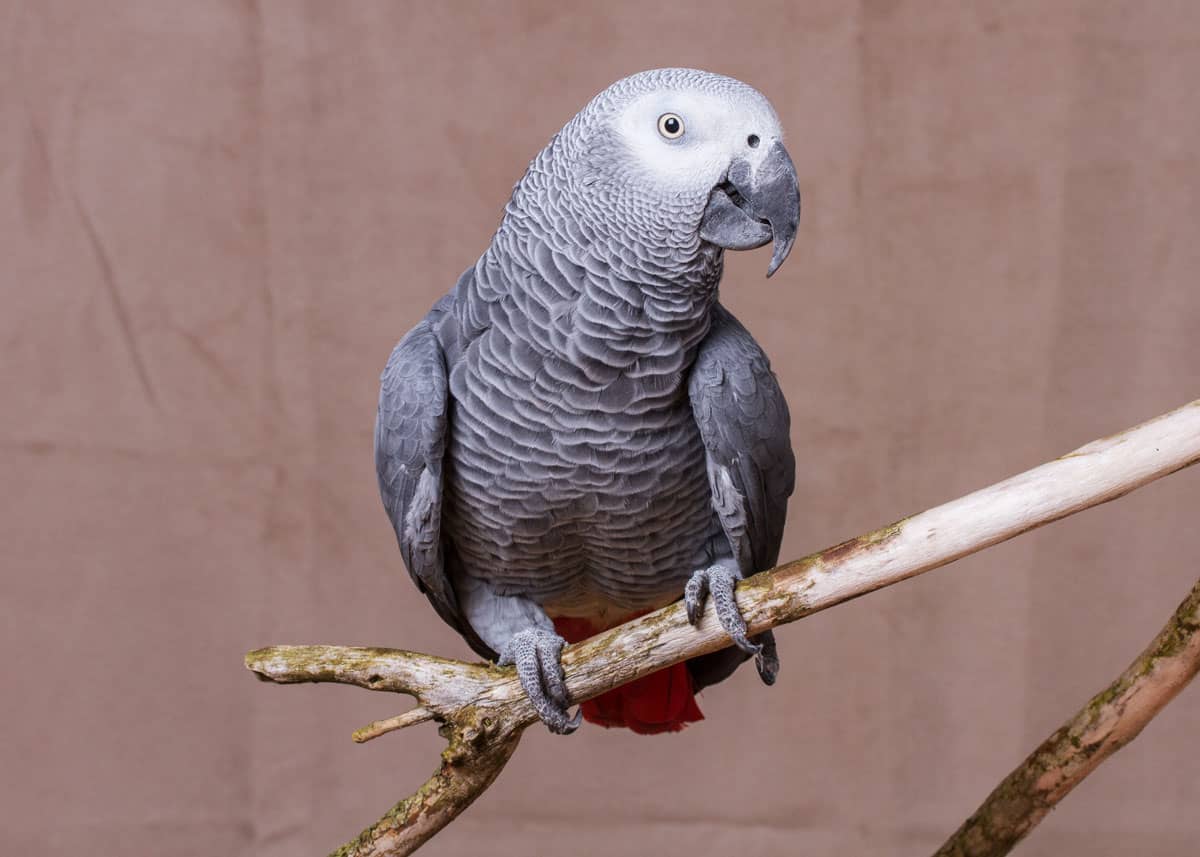
More reading: Learn about the most famous animals in Uganda.
Keeping African Grey Parrots as a Pet
Are you interested in owning an African grey parrot as a pet? Before you set up a perch, here are a few things you might want to know.
36. Are grey parrots good pets?
It depends on your definition of “good.” African grey parrots are intelligent creatures that can make fun, active, and playful pets. But they’ll also require a lot of time and attention. You can’t just lock them in a cage and forget about them. They won’t let you!
For example, African grey parrots are easily bored. If you aren’t providing them with enough stimulation, they might start bothering you with loud chatter and movement. They’ve also been known to take out their boredom on other birds, so they can become a bit of a problem child for you if you own a whole menagerie.
If you’re thinking of adopting an African grey parrot, make sure that you’re ready for a full-time, long-term commitment. They can be a lifelong companion, but you have to be willing to put in the work.
It’s a good idea to pick up a book about caring for grey parrots before buying one. It’s better to know what’s involved before you’ve committed to being an owner.
37. Is it legal to have an African grey parrot as a pet?
You’ll need to check your local laws.
While it’s illegal to buy or sell wild-caught African grey parrots, there are loopholes for captive-bred birds.
This is why you might see African grey parrots in pet shops even though they’re considered an endangered species.
Note: Always check with your breeder/pet shop to confirm that the parrot you are considering was bred in captivity. Wild-caught African parrots are endangered and illegal to buy/sell.
38. How much do grey African parrots cost?
African grey parrot prices start at $1,000 and can climb to $4,000 or more!
Younger birds are more expensive than older ones, and females are more valuable than males.
39. How do I teach my African grey to talk?
Most parrots are intelligent enough to start picking up human speech even when they aren’t trained to do so.
If you want to teach them something specific, however, here are a few tricks:
- Start small. Don’t expect them to recite Hamlet right off the bat! Teach them simple phrases like “hello” and “goodbye,” and once they’re comfortable with their new vocabulary, start incorporating the words into a back-and-forth dialogue.
- Repeat yourself. This is how parrots learn to recite full commercials. They hear them over and over again, and the repetition drills it into their brains.
- Use a reward system. Give your parrot a treat every time that they mimic you. Positive reinforcement is a time-honored tradition among pet owners.
- Don’t expect perfection. Some parrots are better “talkers” than others, and no amount of practice will be able to change that. For example, some might be able to gossip like a schoolgirl while others can only squawk a limited number of syllables. Love your African grey parrot for the parrot that it is, not the parrot that you want it to be!
40. Can parrots understand humans?
Yes. As a species, parrots are known for their ability to understand and copy human speech.
African grey parrots are among the smartest of their entire family, so you should have no problem teaching them how to chat with you.
41. Do African grey parrots bite?
Yes. When they’re bored, stressed, frustrated or ill, African grey parrots can get nippy.
It’s part of a series of behaviors that African grey parrot owners have to deal with; these birds can engage in everything from nail-grinding to feather-plucking when acting out. They have the same cognitive abilities as a 3 to 6-year-old, so you basically have to treat them like toddlers that will misbehave when they’re not feeling well.
It isn’t always a behavioral issue; it can be a sign of affection. Unless you like bleeding fingers, however, it probably isn’t a habit that you should encourage.
42. What kind of cage do you need for an African grey parrot?
Several things go into a good cage purchase for African grey parrots:
- Size. African grey parrots need room to stretch their wings, so the recommended cage size is at least 3 – 4 feet on all sides. Another thing to note is that width is just as important as height, so rather than investing in a high, narrow cage, try to find something with more equal measurements.
- Hiding places. African grey parrots have strong prey instincts, and their natural habitat is a thick forest canopy with lots of leaves and tree holes. They won’t be comfortable in a big, open cage where they’re constantly exposed to the light. Give them places where they can retreat.
- Perches. African grey parrots love to perch, but they’re not always stable. They’ll need wide, solid surfaces that they can securely grip to keep them from taking a fall and hurting themselves.
43. Are African grey parrots messy?
It’s not an answer that pet owners want to hear, but yes, African grey parrots can get messy!
In addition to their happy-go-lucky relationship with poop, they’re also fond of ripping up papers, toys, fabrics, and woods as part of their play. Don’t expect your African grey parrot to be a neat and tidy bird.
44. Which parrot is the most intelligent?
This distinction goes to the African grey parrot. They’re generally considered the smartest parrots on the planet. Just ask Alex!
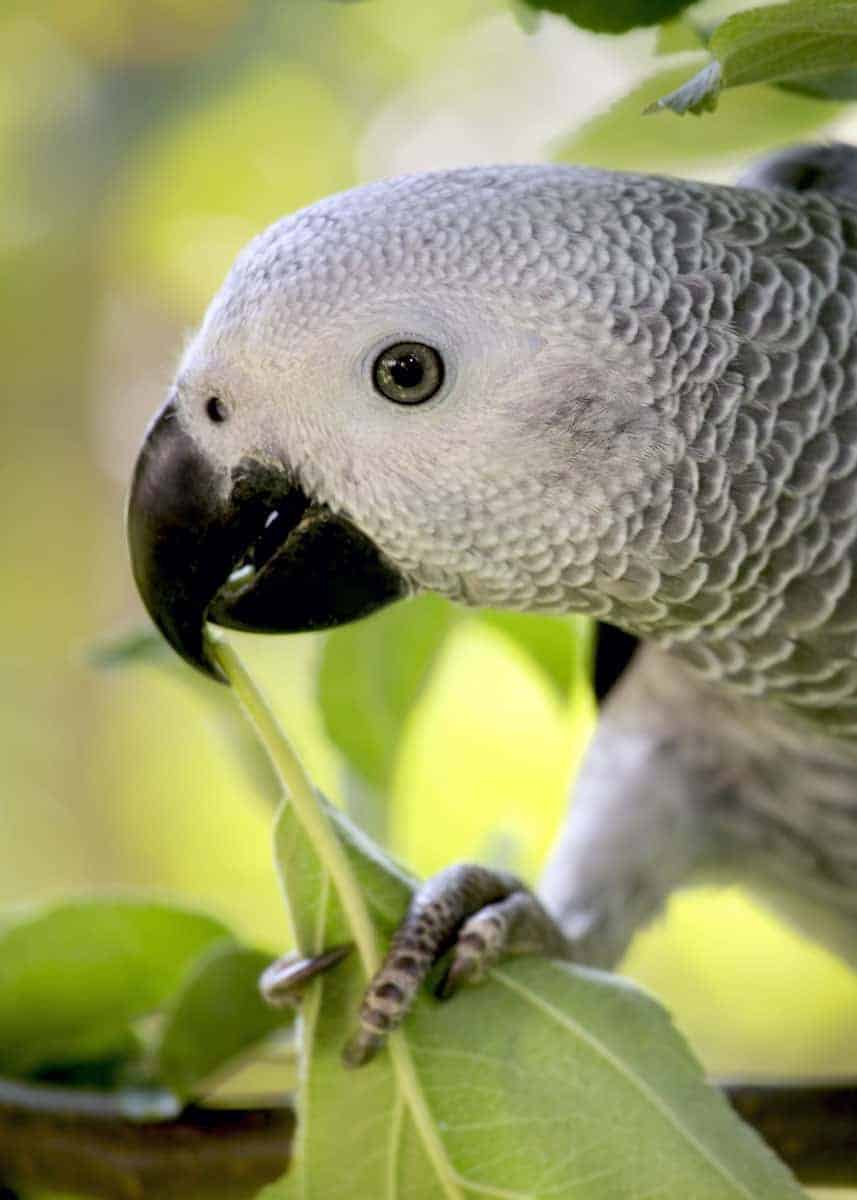
Your turn
These are just a few African grey parrot facts that can help you understand more about the species. Whether you’re planning a trip to Africa or preparing for a new pet adoption, you’ll want to do your research before striking out and looking for red tail feathers!







Very informative. Thanks for writing this.
I have two African grey parrots aged around 3 years but not sure about their sex.
@Ravi Bhatia, please do the dna test
I have a male Gray Parrot,12 years old. Now I want to bring a female for him, How old of female do you recommend.
The only comment i want to make is they the African Gray does not pick up words mainly on repetition. It is mostly on the owners emotions. If something is said out of emotion, the African Gray will pick that word up immediately!! I promise you.
I have well had a african grey but has flew away 2 days ago, is there a way of recovering him?
@Bhargav Patel,
Stay where you last saw him/her and keep calling the parrots name.
How do u treat an injured Grey parrot with a bleeding limb!
Found him helpless on a roof top he had spent there 2 days,
Such a nice blog really helpful and informative. I own an African Grey Parrot.
Thanks Hassan!
@Bryan Haines,
outstanding knowledge about my favourite bird and for my favourite pet.
one odd thing l found about my 30 year old is that hates the color of bright Red
I will always get a nip if I wear bright red around him. I can’t figure why
@Robert Turoff, It’s possibly due to an incident in his early life, perhaps even before you became the pet of your African Grey? Our bird is 14 and she cannot stand the colour brown. Which make perch selection a problem, obviously. We don’t know why, either, though my wife thinks it could be something to do with a neighbour’s child did by banging on our window with a stick when our parrot was a baby.